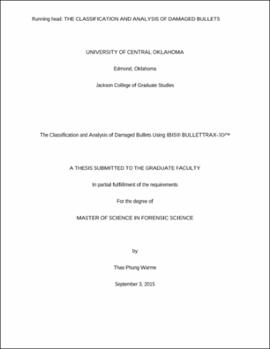| dc.description.abstract | Rifling constitutes the helical grooves created on the surface of the bore of a firearm barrel allowing spin to be imparted on the projectile (Heard, 2008, p. 154). This spin allows the projectile to become more stable, but leaves markings, upon the surface of the projectile. "These lands and grooves create corresponding engraved areas - dubbed land engraved areas and grooved engraved areas (and commonly abbreviated as LEAs and GEAs) - on the bullet surface, separated by shoulders...are the principal areas of interest for observing striations" (Cork, D. et al., 2008, p. 46). The markings left on bullets are necessary for firearms identification. If those markings are damaged, it makes it more difficult for Firearm and Tool Mark examiners and imaging systems to visualize and analyze the markings. There has been a great deal of research regarding terminal ballistics in which the duration of the bullet striking the target is studied, but most of those studies focus on the target being struck, rather than damage to the actual bullet. The majority of these studies determine the velocity and damage caused upon tissue or tissue simulants, such as gelatin, while little research has been completed on other surfaces (Ben-Tovim, 1993, p. 31). In these studies, however, the marks and deformations of the surfaces being struck are assessed, but the damage the bullet has incurred is not generally examined. When the damage to bullets is presented, the data relies on information about velocities of impact rather than the ability to visualize markings and patterns on the surface contours of the bullets themselves (Haag, M. & Haag, L., 2011, p. 114). For the studies that do concentrate on the bullet, none of them concentrate solely on basal damage. There is a lack of bullet deformation research regarding impression evidence. | |
